Driving
Tiger's 5 New Lessons

For most of his professional career, Tiger Woods has been on a mission, as he has often said, to "own" his swing. In the weeks leading up to the Masters, the swing changes he has been working on for more than two years finally seemed to gel, and he looked to be in command of every facet of his game as he regained the No. 1 spot in the World Golf Ranking
. I've been watching Tiger compete for more than half his life--since I first saw him at age 16 playing the Orange Bowl tournament in Miami--and rarely has he displayed such a complete game as he did in winning earlier this year at Torrey Pines, then Doral, then Bay Hill.
From his driver to his approach shots to chipping and putting, he looks very solid and in control. Here's what I see, and what you can take from it.
DRIVER
SET UP IMPACT WITH THE BACKSWING
In his youth, Tiger always had a slightly closed clubface at the top of his backswing--meaning the face was at a more horizontal angle than his left arm (below, left). I like that for most golfers because it requires less hand and arm rotation to square the face in time for impact. Plus, it puts the left wrist in a slightly bowed or rounded position, which is where it needs to be at impact. Many amateurs do the opposite and cup the left wrist, and they have a millisecond on the downswing to get it flat again. Tiger's face position has changed over the years, but now he's back to slightly closed, and I think he'll see better results with the driver.
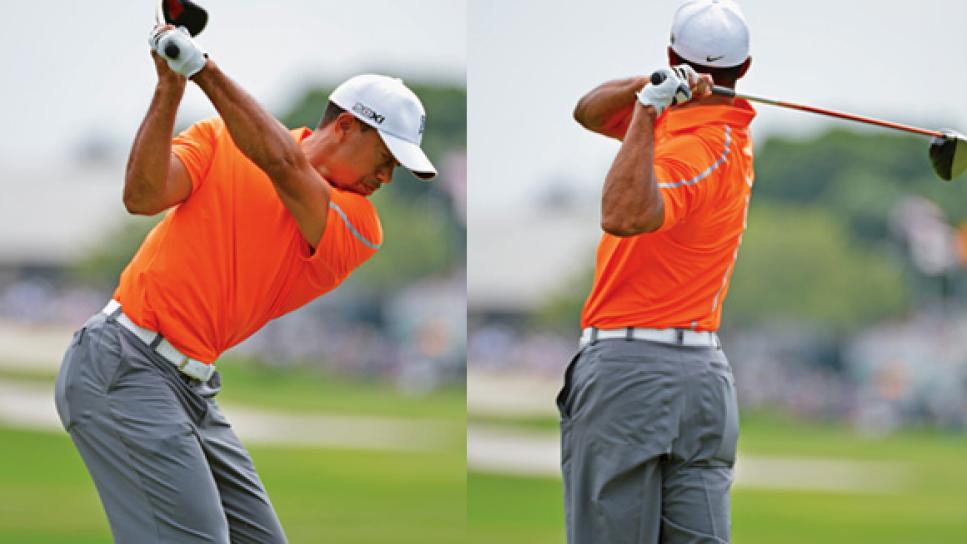
Also, his arms are closer to his body now, so he's more connected. He can hit it hard with his feet, knees, hips and torso--and that means less hand action. Just look at that full body release (above, right).
TRY THIS: A slightly closed face is great for average golfers, promoting a lower-trajectory draw. Strengthen your grip so you see another knuckle on your left hand at address.
5-WOOD
SHIFT LEFT, AND HIT DOWN ON THE BALL
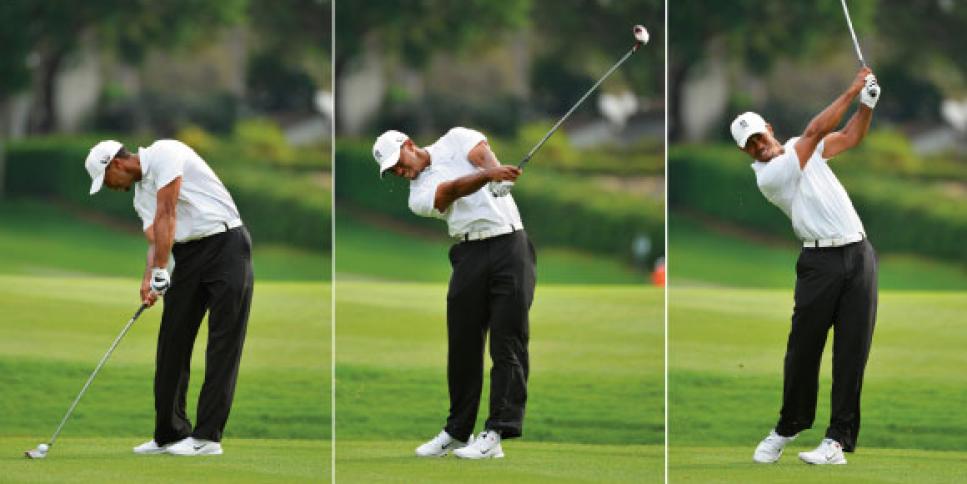
Many amateurs try to sweep their fairway woods, and that leads to hitting off the back foot. Here you can see Tiger does a great job of shifting to his front side. With his 5-wood, he catches the ball with the clubhead still going down, even takes a little divot (notice the grass coming up).
Tiger plays the ball slightly back in his stance--a couple of inches inside his left heel--and stays centered over it on the backswing. Then he makes that aggressive shift to his front foot, and hits down. When you swing down like that, you hit the ball higher on the clubface and launch it higher.
TRY THIS: Play the ball slightly back, shift left from the top, and hit down. Make sure the low point of your swing comes in front of the ball--and even take some grass.
SHORT IRONS
DON'T LET THE CLUB TURN OVER
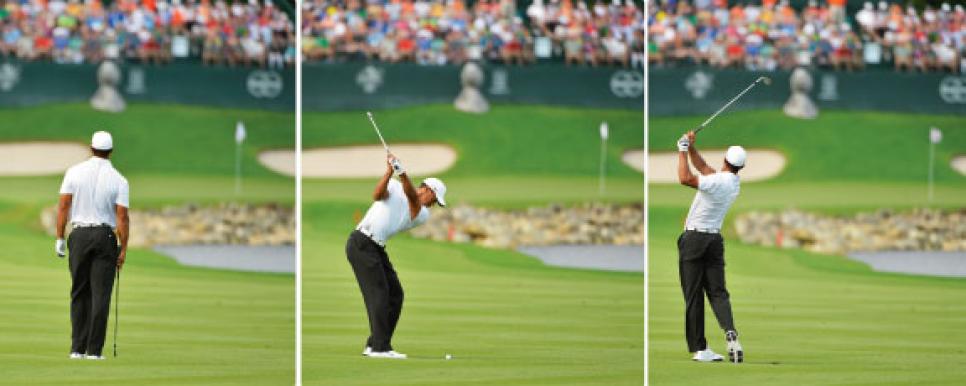
Visualization is big for Tiger, as it was for Jack Nicklaus. In this first photo (above, left) Tiger is visualizing a left-to-right shot into No. 18 at Bay Hill. But what I really like here is that this swing is absolutely hookproof; he has eliminated the left miss. He sets up open, makes a fairly vertical backswing, then holds off the release through impact. Notice how the clubhead is well to the right of his hands in the follow-through--he didn't let the club turn over. Tiger has at times been a bit of a picker with his irons, but I see better divots from him now. Try this: Take an open stance on short irons, and swing the club along your stance line. You'll make a little steeper swing and produce good ball-then-turf contact.
CHIPPING
TURN YOUR BODY, RETURN THE SHAFT
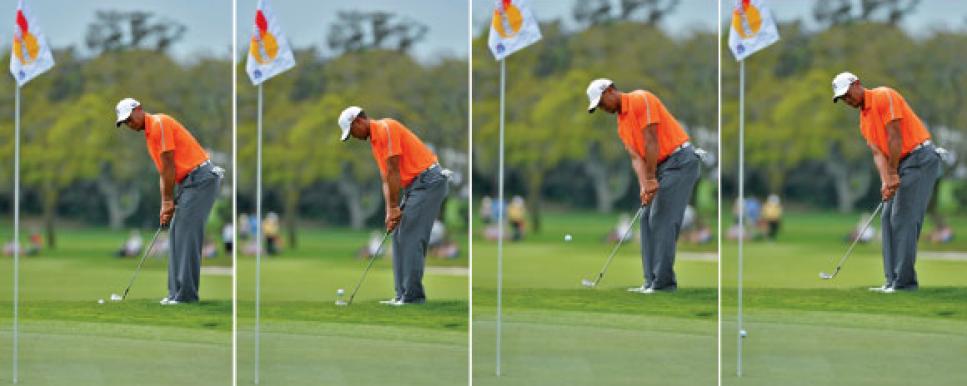
Again, great visualization here from Tiger, who's reading this chip like a putt. As for his technique, for a time he was dragging the handle too far forward through impact, which delofts the club. This is a difficult way to chip, because it brings the club's sharp leading edge more into play. If you don't make perfect contact, a slight miss behind the ball causes a chunk.
Tiger now returns the shaft to its setup position by turning his entire body through to the left and keeping the clubhead low after impact. He's not leaning the shaft excessively toward the target, as I saw him doing last year.
TRY THIS: Use the flange or bottom of the sand wedge as a rudder to help the club glide through the grass. To do that, you have to avoid pushing your hands way forward. Get it right, and a slight miss won't be bad and might not even be noticed.
PUTTING
BRUSH IT WITH THE LEFT HAND
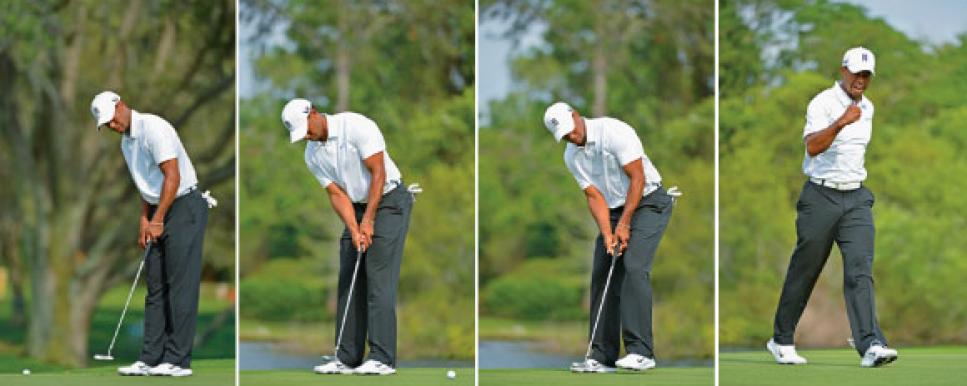
At Doral in March, Tiger got a putting lesson from his friend Steve Stricker, one of the best putters on tour. Stricker putts with a square stance and uses a left-hand drag action through the ball. I think Tiger had gotten open with his body, and Steve helped him square up. Plus, he seemed to smooth Tiger's tempo.
The idea of the left hand controlling the stroke is different for Tiger, who has often practiced with his right hand only. In the first image here, notice that he's making a left-hand-only practice stroke. I also think Stricker, whose putter seems to just brush the ball off the grass, helped Tiger take some of the hit out of his stroke.
TRY THIS: Strive for a smooth rhythm, start to finish. Instead of a rapid strike, think of it as a brush stroke. You'll make more putts, which is what Tiger's doing.

.jpg)